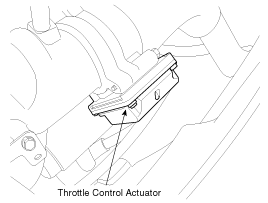
The Throttle Control Actuator is mounted on throttle body of diesel engine and controls throttle valve according to PWM (Pulse With Modulation) signal from ECM.
It consists of;
a DC motor which actuates the throttle valve,
a 2-step gear (transmission ratio = 1:40) which is located in between the DC motor and the throttle valve and increases torque of the DC motor,
a position sensor which is a hall-effect sensor and detects status of the throttle valve,
an electric control unit which is a micro-controller and drives the DC motor by the PWM (Pulse With Modulation) signal from the ECM,
and a reset spring which resets the de-energized throttle valve to its open position.
Its function is described below:
Anti-judder function: When engine is shut off, the ECM can prevent intake air from entering to intake manifold by fully closing the throttle valve for 1.5 seconds (95% < Duty < 97%) to reduce engine vibration.
Intake air control for EGR: When exhaust gas pressure is equal to or lower than intake air pressure (for example, when low engine speed), the exhaust gas would not enter to the intake manifold. At this time, the ECM partially closes the throttle valve (5% < Duty < 94%) to reduce the intake air quantity. The intake air pressure thus is lower than the exhaust gas pressure.
Exhaust gas temperature control for CPF regeneration: When the Catalyzed Particulate Filter (CPF) is need to regenerate, the ECM partially closes the throttle valve (5% < Duty < 94%) to reduce the intake air quantity. At this time, the air-fuel ratio would become rich and the exhaust gas temperature would be high enough to burn the soot inside the CPF.

Duty (%) | Throttle Valve Position |
5 | Open |
5 ~ 94 | Normal operation (Partially open in proportion to duty value) |
94 | Closed |
94 ~ 95 | Maintaining the last valid position |
95 ~ 97 | Fully closed |


Turn ignition switch OFF.
Disconnect the electric throttle control actuator connector.
Measure resistance between terminal 1 and 2 of the valve.
Specification: Refer to "SPECIFICATION".